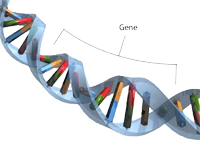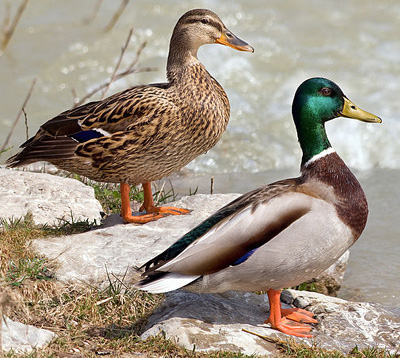 |
Mallard
Ducks
All domestic
ducks except the Muscovy started genetically with the Mallard or wild duck
(Anas platyrhynchos). The Muscovy duck (Cairina moschata) is in a different
genus.
The photo on the left is Mallard ducks: female is top left, male is bottom
right. The photo to the right is Indian Runner ducks.
Wild mallard ducks will on rare occasions lay very light-green eggs, though usually they are white.
|
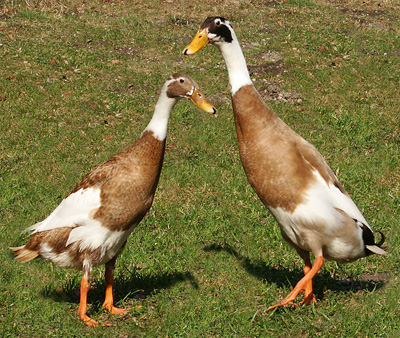 |
Runner
Ducks
The Ancona
duck has Runner duck in it. Any color found in Runner ducks can be found
in Ancona ducks. Colors other than the ones listed below are possible.
Some colors are Fawn, Black, Buff, Chocolate, Silver, Cumberland Blue, Blue
Dusky, Apricot Dusky, Apricot Trout, Blue Trout, and Gray.
"The Runner cannot help but lay large, white and green shelled eggs of a most delicious flavour." -Levi D. Yoder, Natural and Artificial Indian Runner Duck Culture, Pennsylvania, 1910.
|
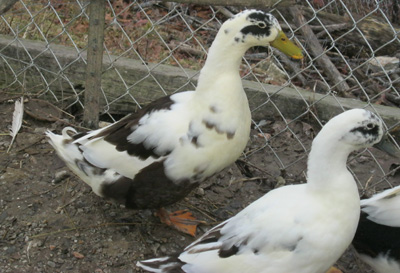 |
Definition
of "Duck"
The precise
meaning of the word "duck" in a sentence can be confusing.
"Duck" is sometimes used to mean all ducks, both male and female. At other
times it means only the female waterfowl, such as mating a duck and drake.
To avoid confusion, I use "female duck" when the gender is important.
This photo is an Ancona drake (on left) and female duck. Drakes have a curly
tail.
|
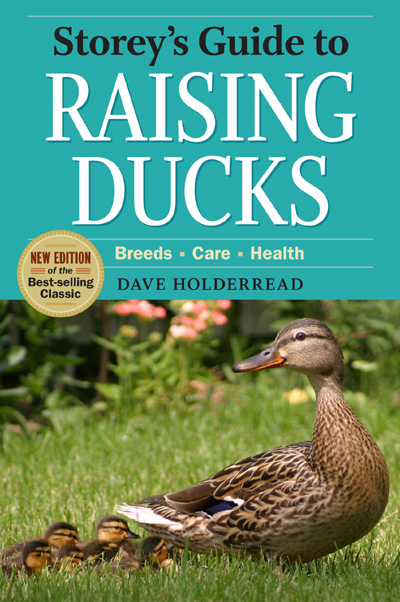 |
Storeys
Guide to Raising Ducks
For more information
about duck genetics, read "Storeys Guide to Raising Ducks" by
Dave Holderread. Chapter 10 is "Understanding Duck Colors".
"For any given trait the original form found in the wild ancestors of domestic
ducks is known as the wild type. Keep in mind that Gray is the official
name in North America for any duck that is colored exactly like a wild Mallard."
-page 112
"Alternative forms of a gene are called alleles. If a gene has one recognised
mutation form, then it is said to have two alleles (the wild type plus the
mutation form). If a gene has two recognised mutation forms, then it is
said to have three alleles (the wild type plus the two mutation forms)."
-page 112
"If a duck carries a matched pair of genes at a particular locus, it is
said to be homozygous for that location. If it carries different alleles
at a locus, it is called heterozygous." -page 112 |
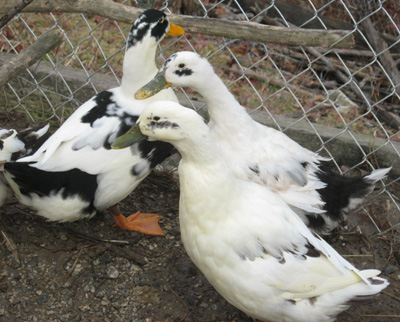
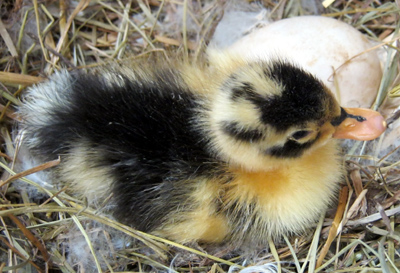 |
Most
Common Ancona Duck Color is Black
Black is the
foundation (base) of all the other Ancona colors. It is dominant.
Mallard female duck (gray=wild type) with 1 Extended Black allelle and no
Blue or Chocolate alleles= all black. It is heterozygous. (All Ancona ducks
are heterozygous.)
The first photo is 3 Black Ancona ducks. The next photo is a Black Ancona
duckling.
"It was an absolute pleasure doing business with you. I hope your farm has great success. I'm so glad I found you on the Internet.
Thank you for doing such important work and keeping the Anconas alive!" -Jeff, Norridgewock, Maine
|
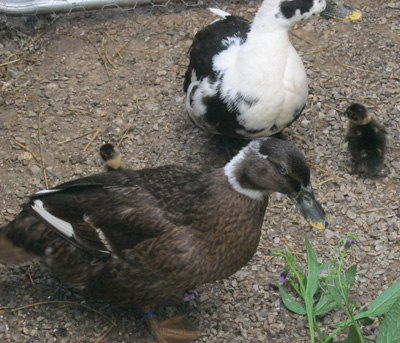 |
Magpie
and Ancona Duck Genetics
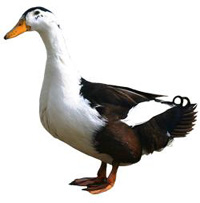
Mallard female duck with 2 Extended Black allelles with white spot pattern
genes= Magpie duck. It is homozygous for that gene.
A Magpie duck has large areas of black on its back, sides and rear. The
rest is white. See photo of drake to the right.
This photo to the left is a Black female and a Tricolor female with their
ducklings from a Tricolor male.
|
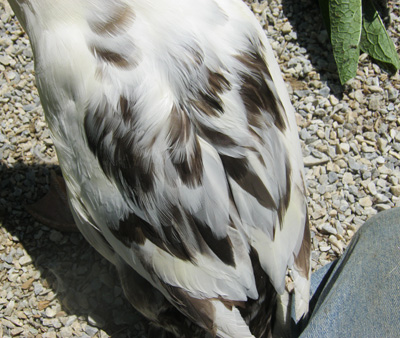
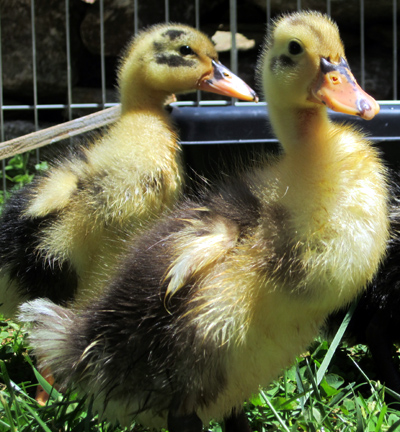 |
Second
Most Common Color is Chocolate
Mallard drake
with 1 Extended Black allelle + 1 Chocolate allelle= looks Black but carries
Chocolate.
Mallard drake with 1 Extended Black allelle + 2 Chocolate allelles= Chocolate.
Mallard female duck with 1 Extended Black allelle + Chocolate allelle= Chocolate.
The female has 1 loci for a Chocolate allelle. A drake has 2. So she can
only inherit Chocolate from her father. It is recessive and sex linked.
The first photo is the tail feathers of a Chocolate male duck. See Lavender
below for a photo of 2 Chocolate ducks.
The next photo is a Chocolate duckling in the front, and a Black duckling
in the back.
"Our six year old granddaughter has been wanting ducks since she was two. This will be a dream come true." -Kim, Cape Cod, Massachusetts
|
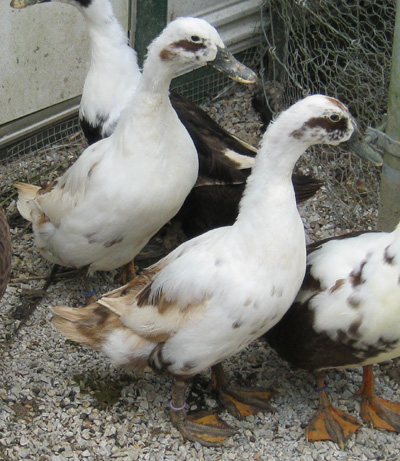 |
Buff
Ancona Duck
There is
a light Chocolate Ancona duck that is the Chocolate gene combined with the
Buff gene. Buff is rare.
This photo is a Buff female duck.
|
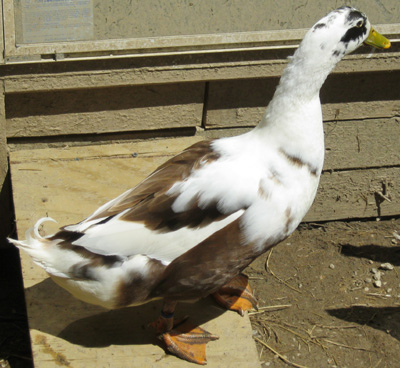 |
Mating
Chocolate Ducks
If a Chocolate
drake mates with a Black duck (female), all female offspring are Chocolate.
All male offspring are Black. This means you can determine the sex of ducklings
when they hatch.
If a Black drake mates with a Chocolate duck, all offspring are black. The
male offspring will carry the sex-linked recessive Chocolate gene. The female
will not.
This photo is a Chocolate drake.
|
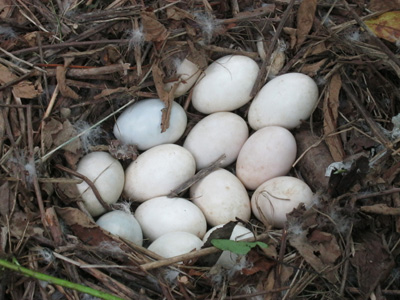 |
Black
& Chocolate Duck Matings
Black
drake x Black duck= 75-100% Black offspring. Those not Black are Chocolate.
Chocolate drake x Chocolate duck= 100% Chocolate offspring.
Black drake x Chocolate duck = 50-100% Black offspring. Those not Black
are Chocolate.
Chocolate drake x Black duck = 50% Black + 50% Chocolate offspring.
"One of the eggs (the blue one) already has a beating heart!!" -Anya, Durham, North Carolina
|
Ancona
Duck Colors & Genetics, Part 2
David
Holderread, Ancona Duck Breeder
|
